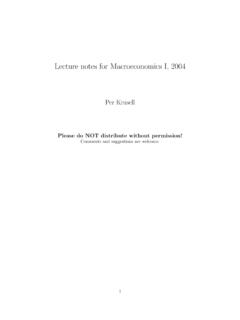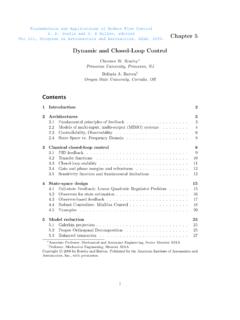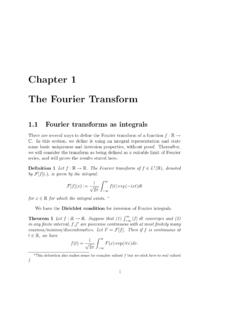Transcription of A Grand Gender Convergence: Its Last Chapter
1 American Economic Review 2014, 104(4): 1091 1119 Grand Gender convergence : Its Last Chapter By Claudia Goldin*The converging roles of men and women are among the grandest advances in society and the economy in the last century. These aspects of the Grand Gender convergence are figurative chapters in a history of Gender roles. But what must the last Chapter contain for there to be equality in the labor market? The answer may come as a surprise. The solution does not (necessarily) have to involve government intervention and it need not make men more responsible in the home (although that wouldn t hurt).
2 But it must involve changes in the labor market, especially how jobs are structured and remunerated to enhance temporal flexibility. The Gender gap in pay would be considerably reduced and might vanish altogether if firms did not have an incentive to disproportionately reward individuals who labored long hours and worked particular hours. Such change has taken off in various sectors, such as technology, science, and health, but is less apparent in the corporate, financial, and legal worlds. (JEL J3, J16, J22, J24, J31, J33, N3)I.
3 Converging RolesOf the many advances in society and the economy in the last century, the converg-ing roles of men and women are among the grandest. A narrowing has occurred between men and women in labor force participation, paid hours of work, hours of work at home, life-time labor force experience, occupations, college majors, and education, where there has been an overtaking by And there has also been convergence in earnings, on which this essay will focus. Although my evidence is for the United States, the themes developed here are more broadly See Goldin, Katz, and Kuziemko (2006) on women s college education.
4 In terms of years of schooling, US women were ahead of men until the 1930s and then regained the lead (Goldin and Katz 2008a).* Department of Economics, Harvard University, 229 Littauer, Cambridge, MA 02138 I thank Amira Abulafi and Natalia Emanuel for excellent research assistance. I am grateful to Larry Katz for his unfailing support and exceptionally high standards, and to Claudia Olivetti for excellent comments. I am grateful to Kathleen Christensen of the Alfred P. Sloan Foundation for being a catalyst and to the Sloan Foundation for funding a related project.
5 I thank Terry K. Adams and J. J. Prescott for giving me access to the University of Michigan Law School Alumni Survey Research Dataset and Stephanie Hurder and Ryan Sakoda for helping me make sense of it. The Midwestern Pharmacy Research Consortium, especially John Schommer and Akeem A. Yusuf, kindly provided the National Pharmacist Workforce Surveys. The author declares she has no financial or other material interests related to this research to disclose. Presidential Address delivered at the one hundred twenty-sixth meeting of the American Economic Association, January 4, 2014, Philadelphia, PA.
6 Go to to visit the article page for addi-tional materials and author disclosure statement(s).1092 THE AMERICAN ECONOMIC REVIEWAPRIL 2014 These parts of the Grand Gender convergence occupy various metaphorical chap-ters in the history of Gender roles in the economy and society. But what must be in the last Chapter for there to be real equality?The answer may come as a surprise. The solution does not (necessarily) have to involve government intervention. It does not have to improve women s bargain-ing skills and desire to compete.
7 And it does not necessarily have to make men more responsible in the home (although that wouldn t hurt). But it must involve alterations in the labor market, in particular changing how jobs are structured and remunerated to enhance temporal flexibility. The Gender gap in pay would be con-siderably reduced and might even vanish if firms did not have an incentive to dispro-portionately reward individuals who worked long hours and who worked particular hours. Such change has already occurred in various sectors, but not in I discuss what is needed to close the Gender gap and what must be in the last Chapter , I should first discuss what is contained in the preceding figurative chap-ters.
8 That will set the stage for the detective work necessary to uncover what the last Chapter must contain. The preceding metaphorical chapters unfolded across at least the last century. Narrowing occurred in a host of economic areas. Changes in labor force participa-tion and the reasons for the changes were discussed in my Ely lecture (Goldin 2006). A Grand convergence occurred in labor force participation for adult women from the early twentieth century to more recently. But a plateau in participation has emerged for US women in most age groups, even for college graduate women, since around the 1990s.
9 The plateau may be related to the relative earnings issues that I will soon discuss. If certain women are disadvantaged in the labor market their participation will be job experience rose along with labor force participation. Years of edu-cation for women increased more than it did for men and it changed in content for secondary and college education toward more investment-oriented and fewer consumption-oriented courses and concentrations. Professional and graduate pro-gram enrollment increased for women so that about half of all law and medical enrollments today are women, and women lead men in fields such as the biological sciences, pharmacy, optometry, and veterinary medicine.
10 Women, particularly college graduates, increased their desire to attain career and family. 3 Hours of work for women increased in the market and decreased in the home relative to those of men. Female earnings rose relative to males in an era that saw women swimming against the tide of generally rising income Thus the various metaphorical chapters that precede the last Chapter explored here are those of a Grand Gender in some economic outcomes has also occurred within various groups of women. Until the 1970s most non-employed adult women had not been in the workforce since they were first married or since having their first child.


















